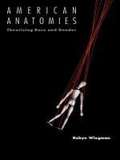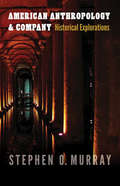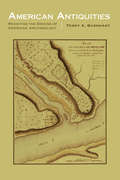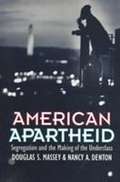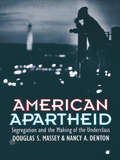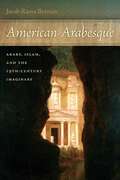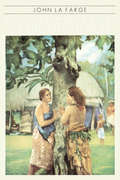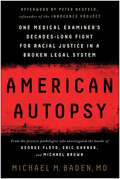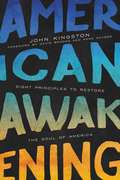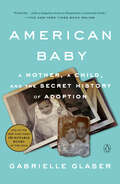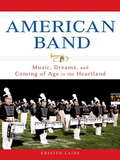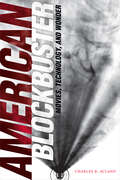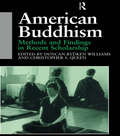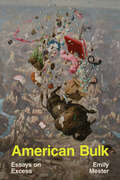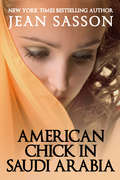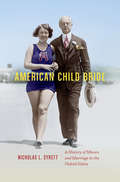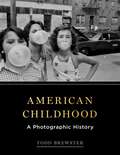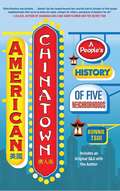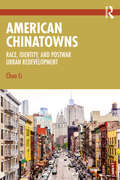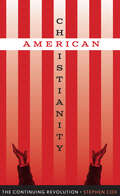- Table View
- List View
American Anatomies: Theorizing Race and Gender
by Robyn WiegmanIn this brilliantly combative study, Robyn Wiegman challenges contemporary clichés about race and gender, a formulation that is itself a cliché in need of questioning. As part of what she calls her "feminist disloyalty," she turns a critical, even skeptical, eye on current debates about multiculturalism and "difference" while simultaneously exposing the many ways in which white racial supremacy has been reconfigured since the institutional demise of segregation. Most of all, she examines the hypocrisy and contradictoriness of over a century of narratives that posit Anglo-Americans as heroic agents of racism's decline. Whether assessing Uncle Tom's Cabin, lynching, Leslie Fiedler's racialist mapping of the American novel, the Black Power movement of the 60s, 80s buddy films, or the novels of Richard Wright and Toni Morrison, Wiegman unflinchingly confronts the paradoxes of both racism and antiracist agendas, including those advanced from a feminist perspective.American Anatomies takes the long view: What epistemological frameworks allowed the West, from the Renaissance forward, to schematize racial and gender differences and to create social hierarchies based on these differences? How have those epistemological regimes changed--and not changed--over time? Where are we now? With painstaking care, political passion, and intellectual daring, Wiegman analyzes the biological and cultural bases of racial and gender bias in order to reinvigorate the discussion of identity politics. She concludes that, for very different reasons, identity proves to be dangerous to minority and majority alike.
American Anthropology and Company: Historical Explorations (Critical Studies in the History of Anthropology)
by Stephen O. MurrayIn American Anthropology and Company, linguist and sociologist Stephen O. Murray explores the connections between anthropology, linguistics, sociology, psychology, and history, in broad-ranging essays on the history of anthropology and allied disciplines. On subjects ranging from Native American linguistics to the pitfalls of American, Latin American, and East Asian fieldwork, among other topics, American Anthropology and Company presents the views of a historian of anthropology interested in the theoretical and institutional connections between disciplines that have always been in conversation with anthropology. Recurring characters include Edward Sapir, Alfred Kroeber, Robert Redfield, W. I. and Dorothy Thomas, and William Ogburn. While histories of anthropology rarely cross disciplinary boundaries, Murray moves in essay after essay toward an examination of the institutions, theories, and social networks of scholars as never before, maintaining a healthy skepticism toward anthropologists’ views of their own methods and theories.
American Antiquities: Revisiting the Origins of American Archaeology (Critical Studies in the History of Anthropology)
by Terry A. BarnhartWriting the history of American archaeology, especially concerning eighteenth and nineteenth-century arguments, is not always as straightforward or simple as it might seem. Archaeology’s trajectory from an avocation, to a semi-profession, to a specialized, self-conscious profession was anything but a linear progression. The development of American archaeology was an organic and untidy process, which emerged from the intellectual tradition of antiquarianism and closely allied itself with the natural sciences throughout the nineteenth century—especially geology and the debate about the origins and identity of indigenous mound-building cultures of the eastern United States. Terry A. Barnhart examines how American archaeology developed within an eclectic set of interests and equally varied settings. He argues that fundamental problems are deeply embedded in secondary literature relating to the nineteenth-century debate about “Mound Builders” and “American Indians.” Some issues are perceptual, others contextual, and still others basic errors of fact. Adding to the problem are semantic and contextual considerations arising from the accommodating, indiscriminate, and problematic use of the term “race” as a synonym for tribe, nation, and race proper—a concept and construct that does not, in all instances, translate into current understandings and usages. American Antiquities uses this early discourse on the mounds to frame perennial anthropological problems relating to human origins and antiquity in North America.
American Apartheid: Segregation and the Making of the Underclass
by Nancy Denton Douglas MasseyA study of segregation as the root of many problems facing African-Americans today.
American Apartheid: Segregation and the Making of the Underclass
by Douglas MasseyThis powerful and disturbing book clearly links persistent poverty among blacks in the United States to the unparalleled degree of deliberate segregation they experience in American cities. American Apartheid shows how the black ghetto was created by whites during the first half of the twentieth century in order to isolate growing urban black populations. It goes on to show that, despite the Fair Housing Act of 1968, segregation is perpetuated today through an interlocking set of individual actions, institutional practices, and governmental policies. In some urban areas the degree of black segregation is so intense and occurs in so many dimensions simultaneously that it amounts to “hypersegregation.” Douglas Massey and Nancy Denton demonstrate that this systematic segregation of African Americans leads inexorably to the creation of underclass communities during periods of economic downturn. Under conditions of extreme segregation, any increase in the overall rate of black poverty yields a marked increase in the geographic concentration of indigence and the deterioration of social and economic conditions in black communities. As ghetto residents adapt to this increasingly harsh environment under a climate of racial isolation, they evolve attitudes, behaviors, and practices that further marginalize their neighborhoods and undermine their chances of success in mainstream American society. This book is a sober challenge to those who argue that race is of declining significance in the United States today.
American Arabesque: Arabs and Islam in the Nineteenth Century Imaginary (America and the Long 19th Century #11)
by Jacob Rama BermanPart of the American Literatures Initiative Series American Arabesque examines representations of Arabs, Islam and the Near East in nineteenth-century American culture, arguing that these representations play a significant role in the development of American national identity over the century, revealing largely unexplored exchanges between these two cultural traditions that will alter how we understand themtoday.Moving from the period of America's engagement in theBarbary Wars through the Holy Land travel mania in the years of Jacksonian expansion and into the writings of romantics such as Edgar Allen Poe, the book argues that not only were Arabs and Muslims prominently featured in nineteenth-century literature, but that the differences writers established between figures such as Moors, Bedouins, Turks and Orientals provide proof of the transnational scope of domestic racial politics. Drawing on both English and Arabic language sources, Berman contends that the fluidity and instabilityof the term Arab as it appears in captivity narratives, travel narratives,imaginative literature, and ethnic literature simultaneously instantiate and undermine definitions of the American nation and American citizenship.
American Artist In The South Sea
by John La FargeThe American artists John La Farge preceded Gauguin to the Pacific, and in their time his reputation as the modern Pacific painter far overshadowed that of the Frenchman. This remarkable work is the record of a year-long artistic odyssey through the South Seas, during which La Farge braved the volcanoes of Hawaii, visited Robert Louis Stevenson in Samoa, was adopted by a noble Tahitian family and journeyed through the wild hills of Fiji, painting and sketching lyrical studies of island life. Lavishly illustrated with his work, this account of the Polynesian adventures that La Farge shared with his friend the historian Henry Adams is an important contribution to the literary and artistic heritage of the Pacific and a revealing insight into the life of a complex and fascinating man.
American Autobiography after 9/11
by Megan BrownIn the wake of the 2001 terrorist attacks in the United States, American memoirists have wrestled with a wide range of anxieties in their books. They cope with financial crises, encounter difference, or confront norms of identity. Megan Brown contends that such best sellers as Cheryl Strayed’s Wild, Elizabeth Gilbert’s Eat, Pray, Love, and Tucker Max’s I Hope They Serve Beer in Hell teach readers how to navigate a confusing, changing world. This lively and theoretically grounded book analyzes twenty-first-century memoirs from Three Cups of Tea to Fun Home, emphasizing the ways in which they reinforce and circulate ideologies, becoming guides or models for living. Brown expands her inquiry beyond books to the autobiographical narratives in reality television and political speeches. She offers a persuasive explanation for the memoir boom: the genre as a response to an era of uncertainty and struggle.
American Autopsy: One Medical Examiner's Decades-Long Fight for Racial Justice in a Broken Legal System
by Michael M. BadenA revealing history of covering up the true causes of deaths of BIPOC in custody—from the forensic pathologist whose work changed the course of the George Floyd, Eric Garner, and Michael Brown cases Dr. Michael Baden has been involved in some of the most high-profile civil rights and police brutality cases in US history, from the government&’s 1976 re-investigation of the assassination of Martin Luther King, Jr., to the 2014 death of Michael Brown, whose case sparked the initial Ferguson protests that grew into the Black Lives Matter movement. The playbook hasn&’t changed since 1979, when Dr. Baden was demoted from his job as New York City&’s Chief Medical Examiner after ruling that the death of a Black man in police custody was a homicide. So in 2020 when the Floyd family, wary of the same system that oversaw George Floyd&’s death, needed a second opinion—Dr. Baden is who they called. In these pages, Dr. Baden chronicles his six decades on the front lines of the fight for accountability within the legal system—including the long history of medical examiners of using a controversial syndrome called excited delirium (a term that shows up in the pathology report for George Floyd) to explain away the deaths of BIPOC restrained by police. In the process, he brings to life the political issues that go on in the wake of often unrecorded fatal police encounters and the standoff between law enforcement and those they are sworn to protect. Full of behind-the-scenes drama and surprising revelations, American Autopsy is an invigorating—and enraging—read that is both timely and crucial for this turning point in our nation&’s history.
American Awakening: Eight Principles to Restore the Soul of America
by John KingstonA healthy and united America--perhaps a country more united than it has ever been--is truly possible, and it starts with us. John Kingston draws on wisdom from history, science, faith, and culture, along with his own experiences, to offer eight principles for discovering purpose, meaning, and true community. We live in the greatest peace and prosperity that the world has ever known, but Americans are feeling more division, isolation, depression, and despair than ever before. These are issues of the soul. We seem unable to find purpose and meaning. We can't find "the life that is truly life"--a vibrant and purpose-filled way of living best experienced together.From his youth, Kingston has always carried a vision for a free and united America. With an approachable and conversational style, as well as a dash of humor, Kingston draws on a diverse and compelling collection of wisdom--the parables of the Bible and the philosophy of Aristotle, the legacy of Nelson Mandela and the speeches of Abraham Lincoln, the songs of Bruce Springsteen and current studies from the best neuro and social scientists today--to remind us that there is no "them," there is only us, and we're in this together.In American Awakening, Kingston offers eight timeless principles for breaking through this darkness and despair and cultivating a radical togetherness, both here in this country and around the globe. You'll discover the profound impact of:In-person connectionMaking more from lessDiscovering purposeRedeeming adversityResponding instead of reactingFinding your unique sense of belongingWherever you find yourself politically or spiritually, a healthy and united America starts with you. Join the Awakening movement and let's rediscover who we are--together.
American Baby: A Mother, a Child, and the Shadow History of Adoption
by Gabrielle Glaser&“Powerful… Tells a singular story to illuminate a universal truth.&”--The New York Times Book Review The shocking truth about postwar adoption in America, told through the bittersweet story of one teenager, the son she was forced to relinquish, and their search to find each otherDuring the Baby Boom in 1960s America, women were encouraged to stay home and raise large families, but sex and childbirth were taboo subjects. Premarital sex was common, but birth control was hard to get and abortion was illegal. In 1961, sixteen-year-old Margaret Erle fell in love and became pregnant. Her enraged family sent her to a maternity home, and after she gave birth, she wasn't even allowed her to hold her own son. Social workers threatened her with jail until she signed away her parental rights. Her son vanished, his whereabouts and new identity known only to an adoption agency that would never share the slightest detail about his fate. Claiming to be acting in the best interests of all, the adoption business was founded on secrecy and lies. American Baby lays out how a lucrative and exploitative industry removed children from their birth mothers and placed them with hopeful families, fabricating stories about infants' origins and destinations, then closing the door firmly between the parties forever. Adoption agencies and other organizations that purported to help pregnant women struck unethical deals with doctors and researchers for pseudoscientific "assessments," and shamed millions of young women into surrendering their children.Gabrielle Glaser dramatically demonstrates the power of the expectations and institutions that Margaret faced. Margaret went on to marry and raise a large family with David's father, but she never stopped longing for and worrying about her firstborn. She didn't know he spent the first years of his life living just a few blocks away from her; as he grew, he wondered about where he came from and why he was given up. Their tale--one they share with millions of Americans--is one of loss, love, and the search for identity.Adoption's closed records are being legally challenged in states nationwide. Open adoption is the rule today, but the identities of many who were adopted or who surrendered a child in the postwar decades are locked in sealed files. American Baby illuminates a dark time in our history and shows a path to reunion that can help heal the wounds inflicted by years of shame and secrecy.
American Babylon: Race and the Struggle for Postwar Oakland (Politics and Society in Modern America #37)
by Robert O. SelfA gripping portrait of black power politics and the struggle for civil rights in postwar OaklandAs the birthplace of the Black Panthers and a nationwide tax revolt, California embodied a crucial motif of the postwar United States: the rise of suburbs and the decline of cities, a process in which black and white histories inextricably joined. American Babylon tells this story through Oakland and its nearby suburbs, tracing both the history of civil rights and black power politics as well as the history of suburbanization and home-owner politics. Robert Self shows that racial inequities in both New Deal and Great Society liberalism precipitated local struggles over land, jobs, taxes, and race within postwar metropolitan development. Black power and the tax revolt evolved together, in tension.American Babylon demonstrates that the history of civil rights and black liberation politics in California did not follow a southern model, but represented a long-term struggle for economic rights that began during the World War II years and continued through the rise of the Black Panthers in the late 1960s. This struggle yielded a wide-ranging and profound critique of postwar metropolitan development and its foundation of class and racial segregation. Self traces the roots of the 1978 tax revolt to the 1940s, when home owners, real estate brokers, and the federal government used racial segregation and industrial property taxes to forge a middle-class lifestyle centered on property ownership.Using the East Bay as a starting point, Robert Self gives us a richly detailed, engaging narrative that uniquely integrates the most important racial liberation struggles and class politics of postwar America.
American Band
by Kristen LaineIn the spirit of Friday Night Lights comes the stirring story of a marching band from small-town middle America. Every fall, marching bands take to the field in a uniquely American ritual. For millions of kids, band is a rite of passage-a first foray into leadership and adult responsibility, and a chance to learn what it means to be a part of a community. Nowhere is band more serious than at Concord High School in Elkhart, Indiana, where the entire town is involved with the success of its defending state champion band, the Marching Minutemen. In the place where this tradition may have originated, in the city that became the band instrument capital of the world, band is a religion. But it's not the only religion-as legendary director Max Jones discovers when conflicting notions of faith and purpose collide during his final year as director. In this intimate chronicle, the band marches through a season that starts in hope and promise, progresses through uncertainty and disappointment, and ends, ultimately, in redemption.
American Bee: The National Spelling Bee and the Culture of Word Nerds
by James MaguireWhat the bestselling Word Freak did for Scrabble, this riveting narrative now does for the National Spelling Bee. Here is a captivating slice of Americana--part sporting event, part absorbing human drama, and part celebration of the magic of words. Every spring in the nation's capital, after a starting pool of 10 million kids narrows to 250 finalists, America's top young spellers face off in a nail-biting contest. So electric is the drama that millions of viewers tune in to watch ESPN's live telecastBut this national obsession is much more than a sporting story--and this first-ever narrative nonfiction book about the National Spelling Bee immerses the reader in unique subculture, portraying the endearing fraternity of brilliant, eccentric young word nerds who vie for a gold trophy, a hefty check, and a glorious moment of national fame.Author James Maguire, who like the contestants is an inveterate word nut, captures the agony and glory of this singularly American event. He profiles the top five spellers across the country, exploring their hopes and dreams-and strategies for winning--as they prepare for their moment in the spotlight. American Bee takes readers behind the scenes at the National Bee, providing a narrative thrill ride as the tension mounts round by round.
American Blockbuster: Movies, Technology, and Wonder (Sign, Storage, Transmission)
by Charles R. AclandBen-Hur (1959), Jaws (1975), Avatar (2009), Wonder Woman (2017): the blockbuster movie has held a dominant position in American popular culture for decades. In American Blockbuster Charles R. Acland charts the origins, impact, and dynamics of this most visible, entertaining, and disparaged cultural form. Acland narrates how blockbusters emerged from Hollywood's turn to a hit-driven focus during the industry's business crisis in the 1950s. Movies became bigger, louder, and more spectacular. They also became prototypes for ideas and commodities associated with the future of technology and culture, accelerating the prominence of technological innovation in modern American life. Acland shows that blockbusters continue to be more than just movies; they are industrial strategies and complex cultural machines designed to normalize the ideologies of our technological age.
American Borders: Inclusion and Exclusion in US Culture (American Literature Readings in the 21st Century)
by Paula Barba Guerrero Mónica Fernández JiménezAmerican Borders: Inclusion and Exclusion in US Culture provides an overview of American culture produced in a range of contexts, from the founding of the nation to the age of globalization and neoliberalism, in order to understand the diverse literary landscapes of the United States from a twenty-first century perspective. The authors confront American exceptionalism, discourses on freedom and democracy, and US foundational narratives by reassessing the literary canon and exploring ethnic literature, culture, and film with a focus on identity and exclusion. Their contributions envision different manifestations of conviviality and estrangement and deconstruct neoliberal slogans, analyzing hospitable inclusion in relation to national history and ideologies. By looking at representations of foreignness and conditional belonging in literature and film from different ethnic traditions, the volume fleshes out a new border dialectic that conveys the heterogeneity of American boundaries beyond the opposition inside/outside.
American Buddhism: Methods and Findings in Recent Scholarship (Routledge Critical Studies in Buddhism)
by Duncan Ryuken Williams Christopher QueenThis is the first scholarly treatment of the emergence of American Buddhist Studies as a significant research field. Until now, few investigators have turned their attention to the interpretive challenge posed by the presence of all the traditional lineages of Asian Buddhism in a consciously multicultural society. Nor have scholars considered the place of their own contributions as writers, teachers, and practising Buddhists in this unfolding saga. In thirteen chapters and a critical introduction to the field, the book treats issues such as Asian American Buddhist identity, the new Buddhism, Buddhism and American culture, and the scholar's place in American Buddhist Studies. The volume offers complete lists of dissertations and theses on American Buddhism and North American dissertations and theses on topics related to Buddhism since 1892.
American Bulk: Essays on Excess
by Emily MesterRaised with hoarding and compulsive shopping, Emily Mester is caught in between. What happens when consumption begins to consume you back? In a series of deeply personal essays, Mester explores how the things we buy, eat, amass, and discard become an intimate part of our lives. We guiltily watch Amazon boxes pile up on the porch, wade through endless reviews to find the perfect product, and crave the comforting indulgence of a chain restaurant. With humor and sharp intellect, Mester reflects on the joys and anxieties of Costco trips, how a seasonal stint at Ulta Beauty taught her the insidious art of the sale, and what it means to get “mall sad.” In a nuanced examination of diet culture and fatness, Mester recounts her teenage summer at fat camp and the unexpected liberation she finds there. Finally, she ventures to Storm Lake, Iowa, to reckon with her grandmother’s abandoned hoard, excavating the dysfunction that lies at the heart of her family’s obsession with stuff. American Bulk introduces readers to a striking new literary talent from the American heartland, one who dares to ask us to regard consumption not with guilt but with grace and empathy.
American Burial Ground: A New History of the Overland Trail (America in the Nineteenth Century)
by Sarah KeyesIn popular mythology, the Overland Trail is typically a triumphant tale, with plucky easterners crossing the Plains in caravans of covered wagons. But not everyone reached Oregon and California. Some 6,600 migrants perished along the way and were buried where they fell, often on Indigenous land. As historian Sarah Keyes illuminates, their graves ultimately became the seeds of U.S. expansion.By the 1850s, cholera epidemics, ordinary diseases, and violence had remade the Trail into an American burial ground that imbued migrant deaths with symbolic power. In subsequent decades, U.S. officials and citizens leveraged Trail graves to claim Native ground. Meanwhile, Indigenous peoples pointed to their own sacred burial grounds to dispute these same claims and maintain their land. These efforts built on anti-removal campaigns of the 1820s and 30s, which had established the link between death and territorial claims on which the significance of the Overland Trail came to rest.In placing death at the center of the history of the Overland Trail, American Burial Ground offers a sweeping and long overdue reinterpretation of this historic touchstone. In this telling, westward migration was a harrowing journey weighed down by the demands of caring for the sick and dying. From a tale of triumph comes one of struggle, defined as much by Indigenous peoples’ actions as it was by white expansion. And, finally, from a migration to the Pacific emerges instead a trail of graves. Graves that ultimately undergirded Native dispossession.
American Chick in Saudi Arabia
by Jean SassonIt all begins with an ad in the newspaper. When Jean Sasson, a young Southern woman living in Jacksonville Beach, Florida, answers a call to work in the royal hospital in Saudi Arabia, what should have been a two-year stay turns into a life-changing adventure spanning over a decade. Over the years Jean is plunged into the hidden lives of the veiled women in Riyadh, where women are locked in luxurious homes and fundamentalist mutawas terrorize the streets. Jean meets women from all walks of life--a feisty bedouin, an educated mother, a conservative wife of a high-ranking Saudi, and a Saudi princess the world knows as Princess Sultana--all who open a window into Saudi culture and help to reshape Jean's worldviews. AMERICAN CHICK IN SAUDI ARABIA is the first installment in a heartfelt, inspiring memoir about Jean's thirty-year travels and adventures in Saudi Arabia, Lebanon, Kuwait and Iraq.Jean's first book THE RAPE OF KUWAIT, based on her eye witness reporting on the invasion of Kuwait by Iraqi troops, was an immediate bestseller. Her next three books, PRINCESS, PRINCESS SULTANA'S DAUGHTERS, and PRINCESS SULTANA'S CIRCLE, became international sensations as they were the first books to bring to the western world the shocking stories about life for women in Saudi Arabia. Jean is also the author of GROWING UP BIN LADEN: Osama's Wife and Son Take Us into Their Secret World and FOR THE LOVE OF A SON: One Afghan Woman's Quest for Her Stolen Child. Her work has been featured in People, Vanity Fair, The New York Times, The Washington Post, The New Yorker, The New York Post, The Sunday London Times, The Guardian, CNN, FOX & NBC.Still traveling the world, Jean has made her homebase in Atlanta, Georgia where she is a passionate animal rights and women's rights supporter.
American Child Bride: A History of Minors and Marriage in the United States
by Nicholas L. SyrettMost in the United States likely associate the concept of the child bride with the mores and practices of the distant past. But Nicholas L. Syrett challenges this assumption in his sweeping and sometimes shocking history of youthful marriage in America. Focusing on young women and girls--the most common underage spouses--Syrett tracks the marital history of American minors from the colonial period to the present, chronicling the debates and moral panics related to these unions.Although the frequency of child marriages has declined since the early twentieth century, Syrett reveals that the practice was historically far more widespread in the United States than is commonly thought. It also continues to this day: current estimates indicate that 9 percent of living American women were married before turning eighteen. By examining the legal and social forces that have worked to curtail early marriage in America--including the efforts of women's rights activists, advocates for children's rights, and social workers--Syrett sheds new light on the American public's perceptions of young people marrying and the ways that individuals and communities challenged the complex legalities and cultural norms brought to the fore when underage citizens, by choice or coercion, became husband and wife.
American Childhood: A Photographic History
by Todd BrewsterA remarkable collection of over 200 stunning photographs of children—from the Civil War era to the present—that captures the ever-changing experience of childhood throughout American history.Did Americans &“invent&” childhood? Author Todd Brewster believes we did, or at least childhood as &“a period of life cordoned off from that of full maturity, covered with a veil of protection, and subject to a program of nurture.&” That&’s the inspiration behind this rich, compelling volume of rarely seen historical images drawn from the photography collections at the Library of Congress, The Metropolitan Museum of Art, the New York Public Library, and the Magnum Photo Agency as well as dozens of other archives, flea markets, and antique shops. The result is a carefully curated paean to American youth: 200-plus photos from all parts of American history, joined by a series of deeply insightful essays on the topic of the American child. American Childhood reveals American children of all types: white, Black, gay, straight, poor, middle-class, upper class, in cities, on farms, at work, at play, lost in reverie, posing for the camera, or captured in their innocence as the lens gazes at them from afar. Some of them would go on to fame: A young Mark Twain is here. So is a juvenile Thomas Edison, Shirley Temple, Lady Gaga, Sammy Davis Jr., Truman Capote, and dozens of others. Can you see the spark of genius in the life of a child? Brewster thinks so. Still, most subjects here are unknown; in many cases a photograph may be the only public trace they have left behind. Both a powerful study of American childhood and a beautiful gallery of extraordinary photography, American Childhood is a terrific addition to an under-appreciated part of American history.
American Chinatown: A People's History of Five Neighborhoods
by Bonnie TsuiCHINATOWN, U.S.A.: a state of mind, a world within a world, a neighborhood that exists in more cities than you might imagine. Every day, Americans find "something different" in Chinatown's narrow lanes and overflowing markets, tasting exotic delicacies from a world apart or bartering for a trinket on the street -- all without ever leaving the country. It's a place that's foreign yet familiar, by now quite well known on the Western cultural radar, but splitting the difference still gives many visitors to Chinatown the sense, above all, that things are not what they seem -- something everyone in popular culture, from Charlie Chan to Jack Nicholson, has been telling us for decades. And it's true that few visitors realize just how much goes on beneath the surface of this vibrant microcosm, a place with its own deeply felt history and stories of national cultural significance. But Chinatown is not a place that needs solving; it's a place that needs a more specific telling. In American Chinatown, acclaimed travel writer Bonnie Tsui takes an affectionate and attentive look at the neighborhood that has bewitched her since childhood, when she eagerly awaited her grandfather's return from the fortune-cookie factory. Tsui visits the country's four most famous Chinatowns -- San Francisco (the oldest), New York (the biggest), Los Angeles (the film icon), Honolulu (the crossroads) -- and makes her final, fascinating stop in Las Vegas (the newest; this Chinatown began as a mall); in her explorations, she focuses on the remarkable experiences of ordinary people, everyone from first-to fifth-generation Chinese Americans. American Chinatown breaks down the enigma of Chinatown by offering narrative glimpses: intriguing characters who reveal the realities and the unexpected details of Chinatown life that American audiences haven't heard. There are beauty queens, celebrity chefs, immigrant garment workers; there are high school kids who are changing inner-city life in San Francisco, Chinese extras who played key roles in 1940s Hollywood, new arrivals who go straight to dealer school in Las Vegas hoping to find their fortunes in their own vision of "gold mountain." Tsui's investigations run everywhere, from mom-and-pop fortune-cookie factories to the mall, leaving no stone unturned. By interweaving her personal impressions with the experiences of those living in these unique communities, Tsui beautifully captures their vivid stories, giving readers a deeper look into what "Chinatown" means to its inhabitants, what each community takes on from its American home, and what their experience means to America at large. For anyone who has ever wandered through Chinatown and wondered what it was all about, and for Americans wanting to understand the changing face of their own country, American Chinatown is an all-access pass.
American Chinatowns: Race, Identity, and Postwar Urban Redevelopment
by Chuo LiAmerican Chinatowns: Race, Identity, and Postwar Urban Redevelopment offers a captivating exploration of the vibrant yet contested landscapes of Chinatowns across the United States.Through a critical and nuanced lens, Li examines how postwar urban redevelopment, racial dynamics, and identity politics have profoundly transformed these iconic neighborhoods. Blending rich historical research with sharp analysis, this book uncovers the interplay of race, urban planning ideologies, and social equity, shedding light on how Chinatowns navigate resilience and reinvention amid shifting urban paradigms. Li’s work highlights the tension between cultural preservation and modernization, exploring the built environment alongside community-driven spatial activism to reveal how these urban spaces persist as sites of resistance, identity, and transformation. American Chinatowns is a compelling study of cultural landscape, urban justice, and the politics of city-making.This book is essential reading for scholars, urbanists, and anyone intrigued by the intersection of race, identity, and the evolving narratives of America’s cities. This book invites readers to rethink the meaning of place, heritage, and equity in the urban fabric.
American Christianity: The Continuing Revolution (Discovering America)
by Stephen CoxThis wide-ranging study examines the ever-evolving forms of Christianity in the US, and why this constant reinvention is a vital part of American faith. Christianity takes an astonishing variety of forms in America: from traditional chapels to modern megachurches, from evangelical fellowships to social-action groups, and from Pentecostal faith to apocalyptic movements. Stephen Cox argues that radical and unpredictable change is one of the few dependable features of Christianity in America. It is in a necessary and ongoing state of revolution and has been throughout our history. Cox explores how both Catholic and Protestant churches have evolved in ways that would make them seem alien to their past adherents. He traces the rise of uniquely American movements, from the Mormons to the Seventh-day Adventists and Jehovah&’s Witnesses, and brings to life the vivid personalities—Aimee Semple McPherson, Billy Sunday, and many others—who have taken the gospel to the masses. Cox also sheds new light on such issues as American Christians&’ constantly changing political involvements, their controversial revisions in the style and substance of worship, and their chronic expectation that God is about to intervene conclusively in human life. Asserting that &“a church that doesn&’t promise new beginnings can never prosper in America,&” Cox demonstrates that American Christianity must be seen not as a sociological phenomenon but as the ever-changing story of individual seekers.
